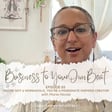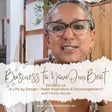
Illuminate Your Sunflower: Newsletter
Today’s episode is made up of a portion of a webinar I I presented, as a part of the Digital Solutions Program titled ‘Newsletter: Frequency, Format & Style, I saw a need for this topic as it kept presenting itself in coaching sessions, clients saying they felt they needed to be producing a newsletter but didn’t know where to begin or what to write about but the biggest obstacle seemed to be that they felt they would be annoying people by sending information directly to their inbox.
In this webinar I started off with sharing the analogy of a sunflower, placing its efforts into thriving to serve the wildlife that it’s designed to support, it doesn’t try to convince an eagle to feed off it’s seeds when an eagle is nourished by small animals, instead it chooses to thrive in a spot that the birds who will be served by the goodness it produces will be attracted to it, these being little finches & rosella’s for example.
Your newsletter is like the sunflower to a finch, it serves it’s needs so you should not be shy to share the goodness you are producing that would nourish the needs of your target audience.
_____________
Monthly Newsletter Sign Up
Access to Full Moon Video Tutorial
Register here for ALL ACCESS or LITE
Digital Solutions Program - Up to 4hrs of 1:1 Coaching for $45+GST
Ad Hoc Business & Wellness Coaching
Supported by THE Rural Woman 1 hr session for $121
Embodiment Coaching Service
Online Store
Intro & Outro Music: Shaman Dance by slavamusic
_____________
By accessing this Podcast, I acknowledge that the entire contents are the property of Marie-Nicole Meunier, or used by Marie-Nicole Meunier with permission, and are protected under AU and international copyright and trademark laws. Except as otherwise provided herein, users of this Podcast may save and use information contained in the Podcast only for personal or other non-commercial, educational purposes. No other use, including, without limitation, reproduction, retransmission or editing, of this Podcast may be made without the prior written permission of the Marie-Nicole Meunier, which may be requested by contacting
soar@creatorsnest.com.au
This podcast is for educational purposes only. The host claims no responsibility to any person or entity for any liability, loss, or damage caused or alleged to be caused directly or indirectly as a result of the use, application, or interpretation of the information presented herein.


















![GUIDEBOOK COMING SOON [Em]Power Dressing image](https://media.zencastr.com/cdn-cgi/image/width=112,quality=85/image-files/63b3af77d968276283751c76/9480c29e-a3be-49be-8569-f68d7bce4e6c.png)
